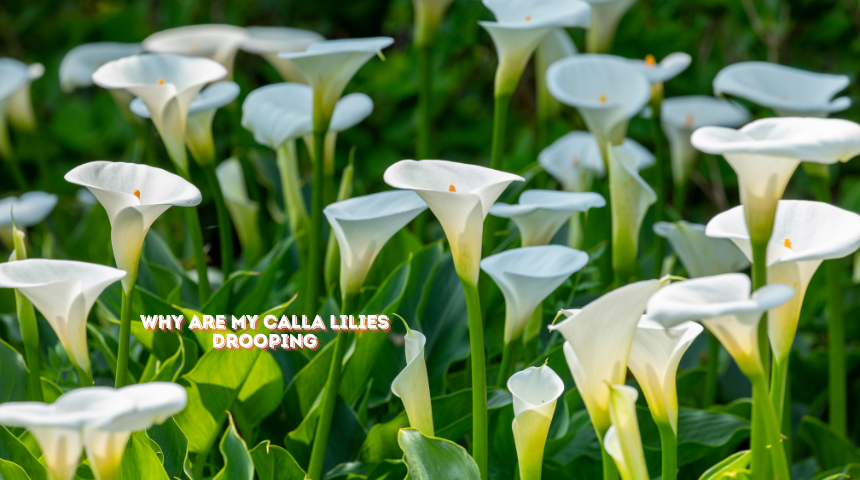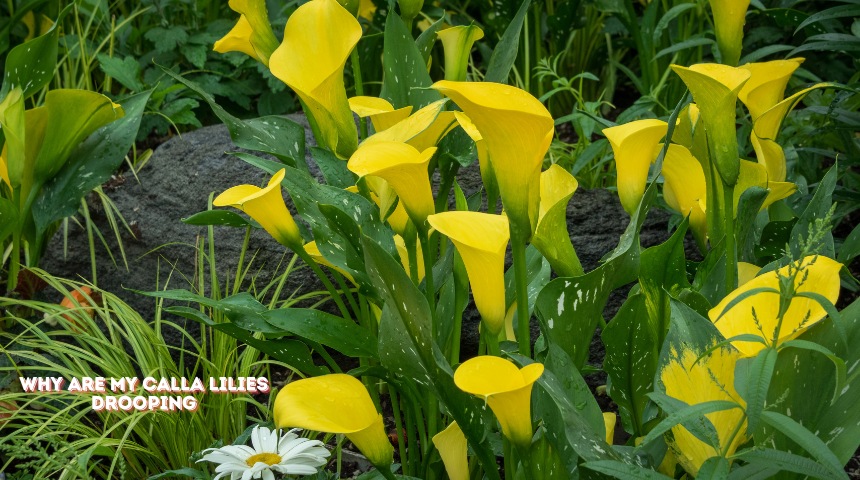Hey there, fellow plant enthusiasts! Today, let’s delve into a common concern: why are my Calla Lilies drooping. As a seasoned gardener and flower lover, I’ve encountered this issue more than once.
Those elegant blooms deserve to stand tall, so let’s explore the causes behind drooping Calla Lilies and how to revive their graceful posture. Join me in uncovering the secrets to keeping these beauties thriving!
Why Are My Calla Lilies Drooping?
Calla Lilies may droop due to overwatering. When the soil gets too soggy, their roots suffocate, causing wilting. Inadequate sunlight can also lead to drooping; these beauties thrive in bright, indirect light.
Another culprit might be poor drainage in their pot or soil, causing waterlogged conditions. Additionally, nutrient deficiencies, particularly lack of nitrogen, may affect their sturdy posture.

Checking these factors will help address why your Calla Lilies are drooping.
Here’s On The Reasons Why Calla Lilies Might Droop
1. Overwatering
When you water Calla Lilies excessively, the soil becomes waterlogged, depriving the roots of essential oxygen. This suffocates the roots, leading to root rot and eventual drooping of the plant.
Ensure proper drainage and allow the soil to partially dry between waterings to prevent overwatering issues.
2. Underwatering
Insufficient watering can cause the leaves of Calla Lilies to wilt and droop. These plants prefer consistently moist soil, so allowing the soil to dry out too much can stress the plant.
Maintain a watering schedule that keeps the soil consistently damp but not soggy.
3. Temperature Changes
Calla Lilies are sensitive to abrupt temperature changes. Drastic shifts in temperature, especially sudden exposure to extreme heat or cold, can shock the plant and lead to drooping leaves.
Ensure a stable environment for your Calla Lilies, avoiding sudden temperature fluctuations.
4. Too Much Nitrogen
While nitrogen is essential for plant growth, excessive amounts can cause issues for Calla Lilies. Too much nitrogen can lead to an imbalance in nutrients, affecting the overall health of the plant and resulting in drooping foliage.

Use a balanced fertilizer and avoid over-fertilizing to maintain proper nutrient levels.
5. Diseases
Calla Lilies can be susceptible to diseases like root rot or fungal infections. These diseases can affect the roots, inhibiting the plant’s ability to take up water and nutrients, ultimately causing drooping and wilting.
Ensure proper soil drainage, avoid overwatering, and promptly treat any signs of disease to keep your Calla Lilies healthy.
How To Fix A Drooping Calla Lily Due To Water?
To remedy a drooping Calla Lily due to water-related issues:
Assess Soil Moisture: Check the soil moisture level by inserting your finger about an inch deep into the soil. If it feels soggy or overly wet, excess water might be the problem.
Adjust Watering: If the soil is waterlogged, allow it to dry out partially before the next watering. Ensure the pot or planting area has adequate drainage to prevent water accumulation.
Report If Necessary: If the Calla Lily is in a container without proper drainage, consider repotting it into a container with drainage holes. This will help excess water to escape, preventing root suffocation.
Trim Affected Parts: Trim any yellow or mushy roots caused by overwatering. Gently remove the plant from its pot and prune away affected areas before repotting in fresh, well-draining soil.
Adjust Watering Schedule: Establish a balanced watering routine, allowing the soil to dry slightly between waterings. Aim for moist, not waterlogged, soil to support healthy root growth and prevent drooping.

Monitor For Improvement: Keep an eye on the plant’s progress. After addressing the water issue, it might take some time for the Calla Lily to recover its turgidity. If the drooping persists or worsens, reassess other potential factors causing the problem.
Should I Trim Drooping Calla Lilies?
Trimming drooping parts of Calla Lilies can be beneficial if the drooping is due to damage or disease. Here’s a guideline:
Damaged Parts: Trim any visibly damaged or yellowing leaves, stems, or flowers. Use clean, sharp scissors or pruning shears to make precise cuts. Removing damaged parts can redirect the plant’s energy to healthier growth.
Diseased Areas: If you notice signs of disease, such as spots, lesions, or fungal growth, trim those affected areas promptly. Cut a few inches below the affected area, ensuring the tool you use is sterilized between cuts to prevent the spread of disease.
Healthy Trimming: Avoid trimming healthy foliage unnecessarily, especially if the drooping is due to environmental factors like overwatering or underwatering. Healthy leaves contribute to the plant’s photosynthesis and overall vigor.

Monitor Progress: After trimming, observe the plant’s response. If the trimmed parts caused the drooping, you should see improvement in the overall appearance and health of the Calla Lily.
Monitor Underneath Your Soil
Keep a close eye beneath the soil surface:
Inspect Soil Health: Peek beneath the surface to check soil moisture and texture. Use your fingers to feel for moisture levels and any unusual textures that might indicate issues like compaction or waterlogging.
Watch For Pests: Occasionally examine the soil for signs of pests like insects or larvae. Some pests live and breed in the soil, causing damage to roots or affecting plant health.
Root Check: Check the roots periodically for any signs of decay, discoloration, or root-bound conditions. Healthy roots are crucial for the overall well-being of your plants.
Soil Amendments: Monitor soil amendments or fertilizers to ensure they are evenly distributed and effectively nourish the plants. Imbalanced soil nutrients can impact growth.
FAQ
Why are my Calla Lilies drooping even though I water them regularly?
Overwatering can suffocate their roots, leading to drooping. Ensure the soil isn’t soggy.
Can underwatering cause Calla Lilies to droop?
Yes, insufficient water can lead to wilting and drooping. Maintain consistent moisture levels.
Do temperature changes affect Calla Lilies’ posture?
Sudden temperature shifts can stress the plant, causing drooping leaves. Keep the environment stable.
Could too much nitrogen in the soil be causing drooping in my Calla Lilies?
Excessive nitrogen can disrupt growth and lead to drooping. Use a balanced fertilizer.
Are diseases a reason behind drooping Calla Lilies?
Diseases like root rot or fungal infections can affect their health, causing drooping. Ensure proper care and treatment if needed.
Conclusion
Friends! We’ve uncovered the mystery behind why those Calla Lilies might be drooping. Remember, these beauties can be a tad sensitive, so keeping an eye on watering habits, soil health, and environmental factors is key to their perky posture.
Whether it’s adjusting the watering schedule or giving them some extra TLC, your Calla Lilies are resilient, and a little care goes a long way in bringing back their graceful charm.
So, dive in, make those adjustments, and watch these stunning blooms stand tall once again – here’s to flourishing gardens and happy, upright Calla Lilies!



